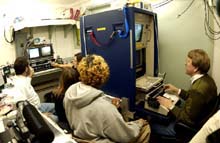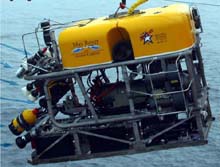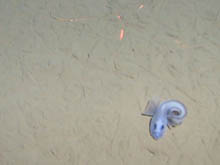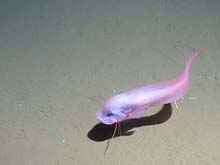
Packed tightly in the cramped quarters of the ROV control van, benthic team members Bodil Bluhm and Casey Debenham peer at the video feed from the ROV along with National Geographic photographer Emory Kristof and writer Jenny Steinberg. Deep Sea Systems Inc. President Chris Nicholson ‘flies’ the ROV from the command consol. (Courtesy of Emory Kristof). Click image for larger view.

Diagram of the lighting and cameras on the Global Explorer ROV. The 2002 Arctic Expedition was the first test of this highly-mobile ROV designed and developed by Deep Sea Systems Inc. (Courtesy of Ian MacDonald, Texas A&M). Click image for larger view and diagram labels.
Getting to the Bottom...of Arctic Seafloor Communities
September 5, 2002
Bodil Bluhm
University of Alaska Fairbanks
The pilot stares at the screen while maneuvering his vehicle gently towards the bottom. He is “flying” the Global Explorer, a brand new remotely-operated vehicle (ROV), by watching live video from one of the vehicle’s cameras. The science team using the ROV is the benthic, or seafloor, group, more affectionately known as the “mud team.”
Our objectives include studying the diversity, abundance, distribution patterns, and food web structure of the unexplored deep sea floor communities. Our strategy is to combine sampling by box cores (large cookie cutters for the sea floor) with detailed visual inspection and targeted collection with an ROV.
Because it can be difficult to sample in deep water, we know little about the sea floor and the organisms that live there, especially in the Arctic Ocean. However, recent technological advances provide the means to change this. One of the major advantages of ROVs over trawls or other nets is that they are virtually non-destructive. We can also see and learn about the animals we seek in their natural habitat.
Counting down until the ROV reaches the sea bottom. 30 meters to go, 20, 10, 5.
There is the bottom. The soft muddy sediment forms clouds as we set down the vehicle. The ROV’s cable is also in view. While providing power to the ROV, this umbilical cord to the ship also provides us with the real-time video images from the numerous cameras attached. Although this is the seventh dive of the cruise, we are still as thrilled as during the first dive 10 days ago.The mellow ice conditions this year allowed us to steam faster than anticipated, so we are devoting the ‘extra’ time to another ROV dive.
As the vehicle moves along the sea floor at 0.2 to 1 knots, we are watching the video screens for life at the bottom of the sea. Right now, we are at 1,800 m (5905 ft) in the area of the so-called “Northwind Ridge,” off the Chukchi Sea shelf. Two video cameras and one still camera allow us to watch and record imagery at different perspectives and distances from the sea floor at the same time. Lighting and camera configurations were modified during each dive, aiming at getting the perfect configuration for our purposes. A set of four green, powerful lasers provide a scale in the images. A bank of four high intensity discharge (HID) lights, augmented as needed with quartz lamps, provides flood lighting in this otherwise pitch-dark environment.

Though the blue fish in this photo, perhaps an eelpout, immediately stands out, the "lebensspuren" (animal tracks, burrows and other signs of life) are just as interesting. The high density of lebensspuren indicate a low current environment. Click image for larger view.

Video footage and still images of all fish encountered during the ROV dives, like this one, will be passed along to taxonomists at the Smithsonian Institution for proper identification. Click image for larger view.
My notes of this dive say something like this:
Tape 3, 45 min - A fish, probably some kind of eelpout, is curled up just in front of the camera. It then swims off , leaving a zigzag cloud of soft sediment.
Tape 3, 47 min - A brittle star, partly burrowed into the sediment, the tips of its five arms sticking up into the water column. Minutes of nothing but mud and darkness.
Tape 3, 58 min – A deep hole in the bottom with a marker beside it. Yeah!! We found our box core marker. It was at exactly this location that we took a box core. Now we have proof that our sample represents the surrounding habitat. Cheers in the ROV van. The phone is ringing, “Congratulations” from the upstairs ROV lab. Changed tapes at 14.00 hours.
Tape 4, 4 min - Another fish, a different one, maybe a snailfish, pink in color and rattail-like in shape.
Tape 4, 5 min - Yet another brittle star, larger than the first, about 3 inches in diameter from one arm to the other; seems like the same species, though. Tried to catch one with the manipulator arm, but the vehicle drifted too fast over the object of desire. Luckily, we caught a specimen in one of our box cores, looks like the same species.Tape 4, 9 min – Numerous “lebensspuren,” e.g., tracks of animals, indicating a low-current environment. Many more tracks than on the last dive, where we found rocks with hard bottom fauna and many dead remnants like bivalve and gastropod shells, otoliths and empty worm tubes, but few tracks. This indicated a higher energy environment with more water movement.
Tape 4, 13 min – Anemones, that are burrowed in the sediment and only display their tentacle crowns.
Tape 6, 2 min – The captain is calling, we need to leave the sea floor now, the last dive of this cruise. Will this be the last dive forever in the Arctic deep-sea?
NOAA’s Ocean Panel’s statement is right, “there is no mistaking the value of the human eye and brain to explore phenomena and resources of the undersea environment.”
Sign up for the Ocean Explorer E-mail Update List.


























